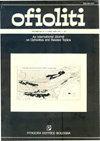慢扩张脊层序化石地幔剖面蛇纹石化历史:来自意大利托斯卡纳南部波马亚采石场的证据
IF 1.3
4区 地球科学
Q2 GEOLOGY
引用次数: 3
摘要
在波马亚采石场(意大利托斯卡纳南部),暴露出一个由内利古里亚单元橄榄岩组成的地幔剖面。该地幔剖面被认为是Ligure-Piemontese海洋盆地侏罗纪海洋岩石圈的代表,通过对含蛇纹脉体系的研究,为完整地重建橄榄岩的蛇纹化历史提供了机会。重建的橄榄岩构造-岩浆历史包括构造结构的发育和辉长岩岩脉的侵入。随后,辉长岩及其与橄榄岩的边界被高t糜棱岩剪切带切割,然后被厚碎裂剪切带切割。辉长岩熔体侵入后,在寄主岩中形成了多套含蛇纹石脉体,切割了橄榄岩。构造、岩相学和矿物学资料表明,所研究的地幔发育脉层序。该序列包括:1)由块状结构的蜥蜴石充填的静脉;2)由块状和纤维状结构的温石棉充填的静脉;3)由反长花岗岩充填的静脉。本文首次提供了内利古里亚单元橄榄岩中蛇纹石化与一系列不同脉纹事件有关的证据。这些事件是在一个缓慢扩张的山脊环境中,由构造控制和岩浆控制的橄榄岩水化交替主导的历史的反应。根据这一重建,波马亚橄榄岩代表了在一个缓慢扩张的脊系的海洋伸展构造阶段形成的数百万颗橄榄岩的核心。本文章由计算机程序翻译,如有差异,请以英文原文为准。
SERPENTINIZATION HISTORY IN MANTLE SECTION FROM A FOSSIL SLOW-SPREADING RIDGE SEQUENCE: EVIDENCES FROM POMAIA QUARRY (SOUTHERN TUSCANY, ITALY)
In the Pomaia quarry (Southern Tuscany, Italy) a mantle section consisting of peridotites belonging to the Internal Ligurian units is exposed. This mantle section, that is regarded as representative of the Jurassic oceanic lithosphere of the Ligure-Piemontese oceanic basin, provides the opportunity for a complete reconstruction of the serpentinization history of the peridotites by studying of the systems of serpentine-bearing veins. The tectono-magmatic history reconstructed for the peridotites includes the development of tectonitic textures followed by the intrusion of gabbro dykes and stocks. Subsequently, the gabbros as well as their boundaries with the peridotites are cut by high-T mylonitic shear zones, and then by thick cataclastic shear zones. The peridotites are cut by several systems of serpentine-bearing veins originated in the host rocks after the intrusion of gabbroic melts. All the structural, petrographic and mineralogical data, indicate that in the studied mantle a sequence of veins sequence developed. This sequence includes: 1) veins filled by lizardite with blocky texture 2) veins filled by chrysotile with both blocky and fibrous texture and 3) veins filled by antigorite. This paper provides for the first time the evidence that the serpentinization in the peridotites from the Internal Ligurian units is associated to a sequence of different events of veining. These events developed in response to a history dominated by alternance of tectonic-controlled and magmatic-controlled hydration of the peridotites in a slow-spreading ridge setting. According to this reconstruction, the Pomaia peridotites represents the core of a megamullion built-up dur- ing an oceanic extensional tectonic stage in in a slow-spreading ridge system.
求助全文
通过发布文献求助,成功后即可免费获取论文全文。
去求助
来源期刊

Ofioliti
地学-地质学
CiteScore
2.40
自引率
7.70%
发文量
1
期刊介绍:
Since 1976, Ofioliti provides an international forum for original contributions and reviews in the field of the geodynamics, petrology, geochemistry, biostratigraphy, stratigraphy, tectonics and paleogeography applied to ophiolitic terrains and modern oceanic lithosphere, including their sedimentary cover. Studies of topics such as geodynamics of the mantle, the evolution of orogens including ophiolites and paleoceanography are also welcome
 求助内容:
求助内容: 应助结果提醒方式:
应助结果提醒方式:


